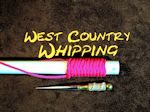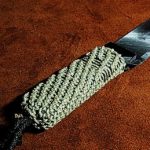Sailmaker’s Whipping – Whipping the End of a Rope
Sailmaker’s Whipping
In this short video I will demonstrate how to whip the end of a rope with Sailmaker’s Whipping. The idea of whipping the end of a rope is to prevent the end of a rope unravelling or fraying, as the whipping binds the end of the rope together. The advantage of whipping the the end of a rope, is that unlike back splicing a rope, the diameter of the rope is not increased.
Whipping Rope
I personally think that Sailmaker’s Whipping is an easy and decorative way of whipping the end of a rope. You may also be interested in this post, Whipping the End of A Rope with 2 Colours.
Sailmaker’s Whipping is perhaps the best permanent whipping for the end of any stranded rope. As with other whippings, it is most effective when applied in waxed whipping twine, a short distance from the end of the rope. The whipping should be as tight as possible, between one and one and a half times the diameter of the rope in length and finished with a reef knot between the strands.
I have to say that when it comes to whipping and other decorative knotting work, I really do love to use this twisted tarred line here: Tarred Line and Size Chart
Sailmaker’s Whipping Video Tutorial
ABoK #3448 – The British Admiralty Manual of Seamanship gives a very ingenious way of whipping that superficially resembles palm-and needle whipping. An ordinary three-strand rope is opened for one and one half to two inches, after first stopping the end of each strand. A waxed twine is middled and a loose loop laid around one strand, then both ends are brought out at the opposite strands. The rope end is carefully laid up again and stopped. The loop and the working end having been left long, with the working end make the required number of turns and put the loop that was left at the bottom over the top of the strand that it encircles. The standing end is now pulled taut, which draws up the loop and tightens the worming. The standing end is next wormed to the top and reef knotted to the working end, between the strands, where it does not show.
| | Whipping Twine is often used for preventing the ends of ropes from fraying. I have also used some for net making |








Pingback:Common Whipping How to Tie | IGKT
Pingback:Seizing a Rope
Pingback:Whipping the End of a Rope (Colour)
Pingback:Decorative Rope Dog Lead | IGKT